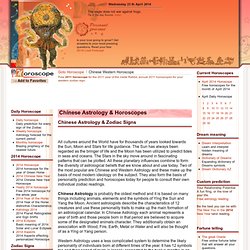

Séquence Horoscope chinois (niveau A2) Site du Nouveau Lycée général et technologique: toutes les informations, horaires, coefficients par discipline, de la seconde à la Terminale. - BO n° 3 du 23 janvier 2014 : Épreuves de langues vivantes applicables aux baccalauréats général et technologique (hors séries L, TMD, STAV et hôtellerie) - B.O n° 43 du 21 novembre 2013 : modifications des épreuves au Baccalauréat général de la série L, applicable à compter de la session 2014 de l'examen. - BO n° 1 du 3 janvier 2013 Dispositions transitoires pour l’épreuve de langue vivante 2 dans les séries STD2A, STI2D et STL (sessions 2013-2016). - BO n° 45 du 6 décembre 2012: Modification des définitions des épreuves d’enseignement technologique en langue vivante 1 et des épreuves de projet en enseignement spécifique à la spécialité dans les séries STI2D et STL, et des épreuves de design et arts appliqués en langue vivante 1 et de projet en design et arts appliqués dans la série STD2A.

Chinese Astrology Horoscope Wisdom of Chinese & Western Horoscopes Correlation. All cultures around the World have for thousands of years looked towards the Sun, Moon and Stars for life guidance.

The Sun has always been regarded as the bringer of life and the Moon has been utilized to predict tides in seas and oceans. The Stars in the sky move around in fascinating patterns that can be plotted. All these planetary influences combine to form the diversity of astrological beliefs that we know about and use today. Two of the most popular are Chinese and Western Astrology and these make up the basis of most modern ideology on the subject. They also form the basis of personality prediction and horoscopes today for people to consult their own individual zodiac readings.
Chinese Astrology is probably the oldest method and it is based on many things including animals, elements and the symbols of Ying the Sun and Yang the Moon. Horoscope. It is used as a method of divination regarding events relating to the point in time it represents, and it forms the basis of the horoscopic traditions of astrology. No scientific studies have shown support for the accuracy of horoscopes, and the methods used to make interpretations are generally considered pseudo-scientific.
In common usage, horoscope often refers to an astrologer's interpretation, usually based on a system of Sun sign astrology; or on the calendar significance of an event, as in Chinese astrology. In particular, many newspapers and magazines carry predictive columns based on celestial influences in relation to the zodiacal placement of the Sun on the day of a person's birth, identifying the individual's Sun sign or "star sign" based on the tropical zodiac.[1] Introduction[edit] Etymology[edit] The Sanskrit term for horo is Hora (होरा).Horo -Scope is hora - shastra( होरा -शास्त्र ).
Concepts in Western Astrology[edit] Angles[edit] Why geysers on Saturn's moon have nonstop eruptions. The Cassini spacecraft has observed geysers erupting on Saturn’s moon Enceladus since 2005, but the process that drives and sustains these seemingly endless eruptions has remained a mystery.

Now scientists have pinpointed the mechanism by which cyclical tidal stresses exerted by Saturn can drive those long-lived eruptions. “On Earth, eruptions don’t tend to continue for long,” says Edwin Kite, assistant professor of geophysical sciences at the University of Chicago. “When you see eruptions that continue for a long time, they’ll be localized into a few pipe-like eruptions with wide spacing between them.” But Enceladus, which probably has an ocean underlying its icy surface, has somehow managed to sprout multiple fissures along its south pole. These “tiger stripes” have been erupting vapor and tiny frost particles continuously along their entire length for decades and probably much longer. A leading candidate for life What’s needed is an energy source to balance the evaporative cooling. Dino Pet – BioPop. The Story...

While on a valiant quest to construct a sustainable biolight (biological light), the mad-ly skilled scientists at BioPop began experimenting with a particular type of bioluminescent plankton, called dinoflagellates, as a possible light source. As they nurtured these dinoflagellates to find the best way to make them glow, the BioPop scientists came to a revolutionary realization: dinoflagellates is kinda hard to say. Their solution? Calling them ‘dinos’ for short, of course. Next, they came to two even-more-revolutionary realizations: 1) the dinos required too much external stimulation (shaking) to make a truly sustainable biolight, and 2) the subjects of this pet project were kind of like a pet… The coolest pet ever!
With a minimal amount of nurturing, the dinos would create a light show. As the dust settled from their aha moment, they realized they needed the perfect home for their dynamic, light-producing new pets. FAQ (Frequently Asked Questions): What are dinoflagellates?